Personally, I eat food all year round – but at Christmas it feels as though you’re not doing your civic duty if you don’t tick off mince pies, chestnuts and mulled wine alongside a box of choccies and some shortbread biscuits. If you thought this was a modern day phenomenon you’d be wrong. Very wrong.
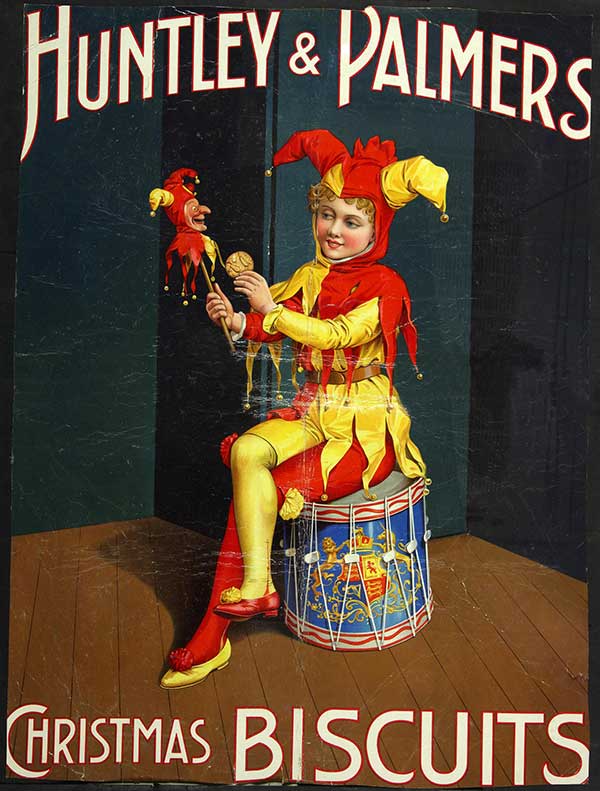
Promotional art work for Huntley and Palmer’s Christmas Biscuits 1905 (COPY 1/230)
The National Archives is as full as Santa’s sack on Christmas Eve, with advertising and packaging designs for Christmas treats from the Victorian period into the 20th century. Manufacturers wanted to protect their marketing designs so that other companies couldn’t copy them. To do this, they had to fill in a form for the Board of Trade and provide a sample, copy or sketch of the design.
How lucky for us that they did, because these are now housed in The National Archives and provide an amazingly rich glimpse into the styles and tastes of that period.
Some of the companies with designs at The National Archives are still around – like Huntley and Palmer’s biscuits. This company was founded in 1822 by Thomas Huntley and George Palmer, and is still producing biscuits today. This advertisement is for their Christmas biscuits from 1905.
This Palethorpe’s Royal Cambridge sausages image from 1911 doesn’t really tempt me – huge, frankfurter-type sausages on a sledge..? Apparently they don’t know ‘the sort I like’. The company was founded by Henry Palethorpe in 1852, and in the 1990s was incorporated into Northern Foods. It’s still operating but is now part of a Norfolk company called Pork Farms.
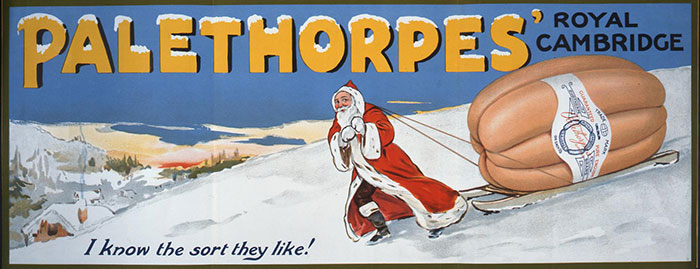
Promotional art work for Palethorpes’ Royal Cambridge sausages 1911(COPY 1/302)
I Love this Christmas price list from 1903 for Sinclair’s in Manchester – who wouldn’t be tempted by their offer of a 10% reduction if you order a whole barrel? And don’t worry, you’re not too late: Sinclair’s Oyster Bar is still operating. It’s a pub these days, but I believe it still serves oysters as well as beer with a head on it (as it should be). Interestingly, the actual building was built in 1720 but was taken apart, brick by brick, and moved about 300 meters when Manchester city centre was regenerated after the Arndale bomb in 1996.
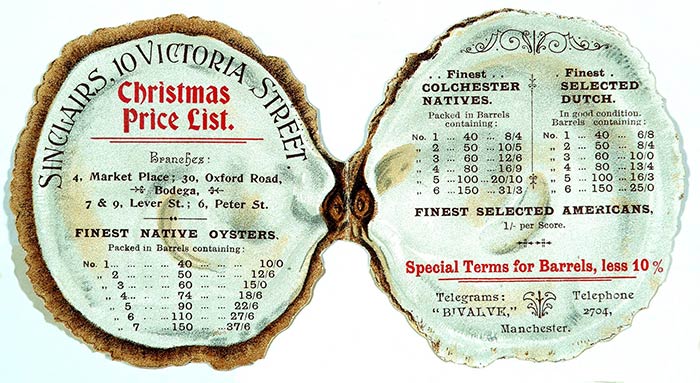
Christmas price list for Sinclairs’ oysters, Manchester 1903
The advertisement below is for a Scottish company with a 200-year-old history. MacFarlane Lang & Co merged in 1948 with McVitie & Price, also Scottish, to form United Biscuits. I’m not sure how to interpret this image of Little Red Riding Hood and the Big Bad Wolf enjoying a rather amicable-looking skating session. Is it about Christmas peace and goodwill to all? The wolf appears to have decided not to eat Little Red Riding Hood or Granny but to share a box of biscuits with them instead.
Not sure I trust that look on his face, though.
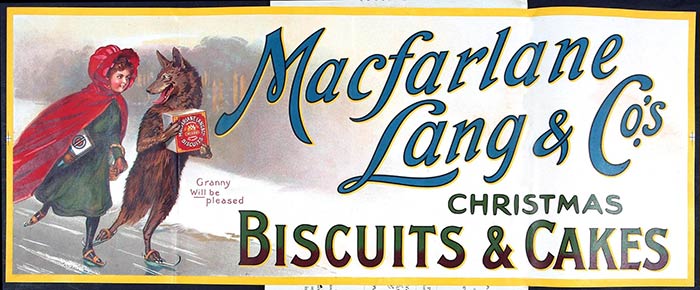
Promotional art work for Macfarlane Lang & Co’s Christmas biscuits & cakes 1903 (COPY 1/207)
Now here’s something to throw into conversation on your Boxing Day walk: who invented the digestive biscuit? Predictably, your walking partners will shout: ‘Alexander Grant who worked for McVities, of course. Next question!’ But that’s your cue to inform them that, actually, some believe it was Robert Middlemass of Peebleshire that first created the UK’s favourite biscuit. The Middlemass Biscuit Factory was in Edinburgh on the corner of Salisbury Place and Causewayside, on the site now occupied by the National Library of Scotland Maps Collection building.
- The digestive biscuit was marketed as having health giving properties
- Robert Middlemass and his wife Helen had nine children
- The last two statements may or may not be connected
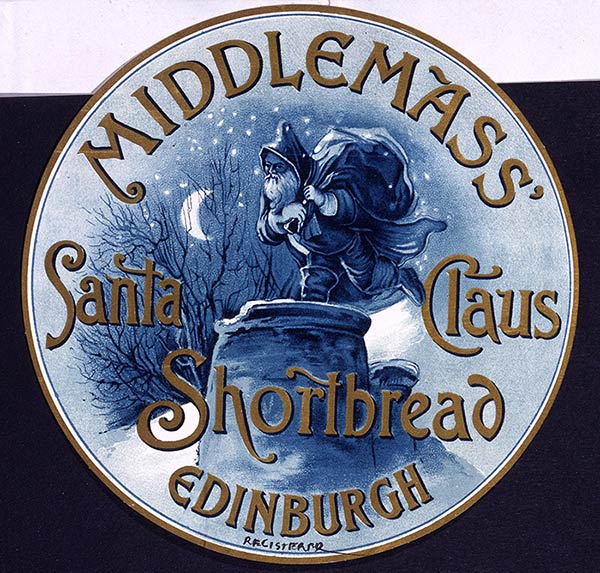
Promotional art work for Middlemass’ Santa Claus Shortbread, Edinburgh 1895 (COPY 1/122)
Christmas is not all about the food though – there’s quite a tradition of seasonal drink that goes along with the celebrations. I believe it’s acceptable in some households to drink champagne at breakfast, as long as you add a bit of orange juice.
In 1903 this advertisement for W T Stoneham’s Argyll Stores, Abergavenny, illustrates the selection of Christmas tipples on offer. Hall’s and Keystone wines were both produced by Henry James Hall, who traded as Stephen Smith & Co in Bow, London. The wines were among many Victorian and Edwardian ‘nervine’ drinks that fulfilled their promise to restore you through the addition of (ahem…) cocaine. One advert in Country Life magazine claimed that Hall’s wine contained ‘nothing but the extractive principals of the coca leaf, and although a powerful nervine, is practically harmless’.
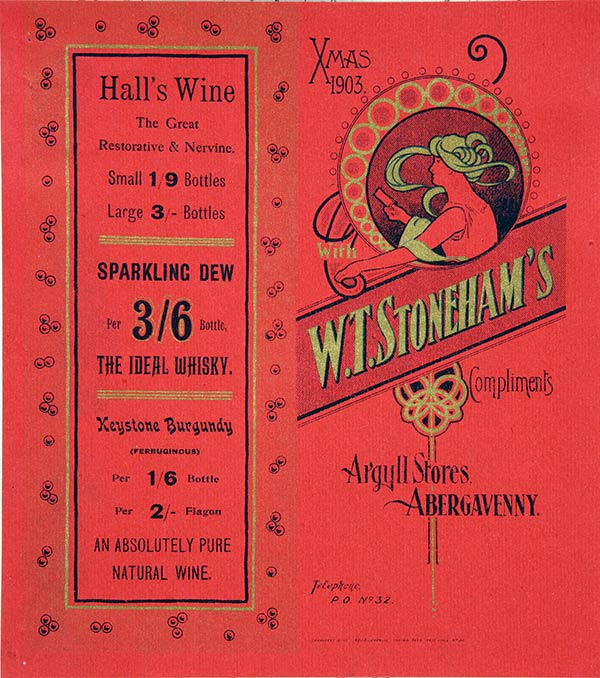
Promotional art work for W T Stoneham’s Argyll Stores, Abergavenny 1903 (COPY 1/212)
These Christmas advertising examples are part of a much wider collection of designs, trademarks, photographs and written works that were registered for copyright protection from the Victorian era up to the 1990s. If you want to know more, you might be interested in our recent series of subtitled webinars that are available on our YouTube channel.
Interesting read, made me reach for the biscuits.
This is lovely, thank you so much.
Thank you for sharing these documents from TNA and for the series of historical Christmas cards. Happy Christmas and a healthy New Year to you all.
This was fun. Thank you.
Happy Christmas.
P.S. I live in the U.S.
These adverts are true works of art and leave you in no doubt what they’re advertising (unlike some of our modern-day TV ads, that leave me thinking ‘what was that all about?’ when they’re over – defeats the object somewhat, I’d say). I love the Tower Bridge card, which is beautiful, the oyster price list and the ‘take’ on Little Red Riding Hood with that malevolent-looking wolf clutching a box of biccies!
Why was a shop in Abergavenny named “Argyll Stores”?
The Nostalgia of thoughtful, warm, creative advertising, as with everything else we are losing, leaves one wondering if modern society will ever look back to those wonderful moments in time and realize that it is pieces of our humanity we are really giving up.
Please note the difference between meters and metres (see the write up about Palethorpes’ sausages).
Dear Sarah,
Love your opening line. Glad you didn’t stop eating during these dark days of killing bugs and mad people.
Happy holidays to you and your team.
Cheers.
Nostalgic article, but having worked in the wholsale grocery trade in the 1960s, it would have been a tin of biscuits.
Good point but the advert was for Oysters not Sausages